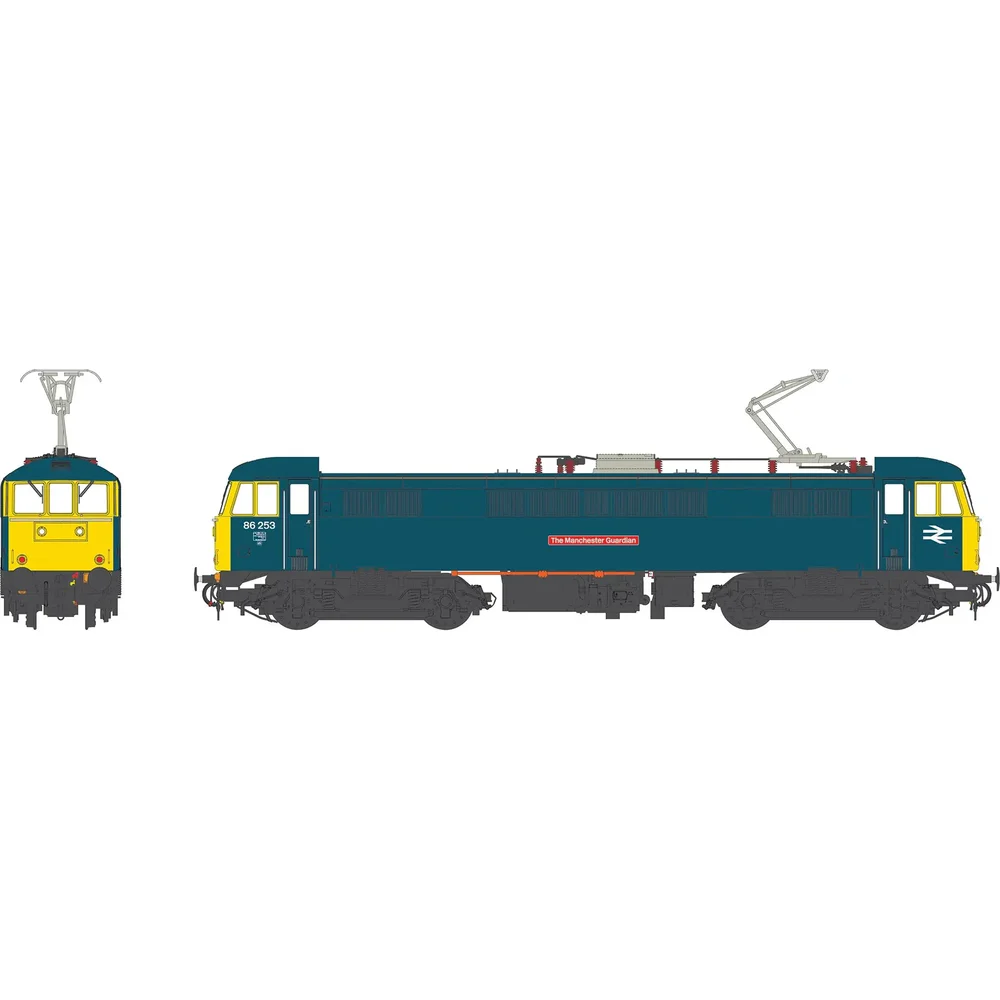Heljan 8621
British Rail Class 86 86253 "The Manchester Guardian" British Rail Blue
Tooling
Heljan’s 2024 upgrade of the British Rail Class 86 in OO gauge represents the latest evolution of its AC electric locomotive range. Building on the 2021 retooling, this version introduced further refinements in accuracy, finish, and digital capability. The focus shifted to the Class 86/2 variant, widely used for high-speed passenger and parcels traffic from the late 1970s onwards. This tooling reflects Heljan’s commitment to meeting modern expectations for detail and functionality in ready-to-run models.
Tooling Features
- Construction: Plastic bodyshell with die-cast metal chassis for strength and weight.
- Detailing: Factory-fitted wire handrails, lamp irons, jumper cables, lifeguard pipework, and bufferbeam detail packs. Cab interiors fully painted with seating and glazing. Sprung Oleo buffers included.
- Pantographs: Choice of Brecknell-Willis high-speed or Stone Faiveley AMBR types, poseable but unpowered.
- Couplings: NEM pockets with tension-lock couplers; cosmetic screw-link couplings supplied.
Mechanical & Electrical
- Motor: 5-pole motor with twin flywheels for smooth, powerful performance.
- Drive: All axles powered; pickups on all wheels for reliable current collection.
- Lighting: Directional headlights and tail lights, cab lighting, and illuminated headcodes. Independently switchable tail lights.
- Weighting: Die-cast chassis for improved adhesion and stability.
DCC Capability
DCC Ready with a 21-pin socket and provision for a 28mm round speaker for sound installation. Fully compatible with advanced sound decoders.
Liveries Produced
- BR Electric Blue (heritage).
- BR Blue.
- InterCity Executive and InterCity Swallow.
- Virgin Trains Red/Grey.
- Anglia Railways.
- EWS Red/Gold.
- Colas Railfreight.
- Parcels Sector Red/Grey.
- Special editions such as “Rainhill 150” commemorative livery.
Reviews & Commentary
The 2024 upgrade was widely praised for its exceptional body shape accuracy, crisp underframe detail, and improved decoration. Reviewers highlighted the enhanced lighting functions and robust mechanism as standout features. Forum discussions noted that the tooling addressed previous criticisms of cab profile and bogie relief, while offering a wide range of liveries appealing to both heritage and modern image modellers. Minor feedback included occasional livery alignment issues, but overall reception was strongly positive.
Media & Social Media
Video reviews from retailers and independent channels showcased the model’s smooth running and fine detail, often comparing it favorably to earlier Heljan releases and rival products. RMweb threads and social media posts praised the breadth of liveries and the inclusion of features such as cab lighting and headcode illumination. Enthusiasts described the 2024 tooling as “the definitive Class 86 for OO gauge” and a benchmark for AC electric models.
Interesting Notes
This tooling introduced two body options to reflect different eras: early 1980s versions without high-intensity headlights and later variants with headlights and Time Division Multiplex (TDM) cables. The model also featured refined pantograph tooling and improved printed decoration, including additional warning labels and data panels.
Class & Prototype
- Class: British Rail Class 86
- Traction: Electric
- Built: 1965-1966
- Total Built: 100
No prototype found.
Operator & Livery
- Operator: British Rail
- Livery: Blue
British Rail (1965-1997) transformed Britain's railways through revolutionary modernisation, introducing the iconic double arrow logo, Rail Blue livery, and business sectorisation. BR pioneered high-speed rail with the InterCity 125 and Advanced Passenger Train, electrified major routes, and created profitable divisions like InterCity and Network SouthEast. From steam succession through diesel and electric development to privatisation preparation, British Rail's diverse locomotive fleet, multiple livery schemes, and operational scenarios provide unparalleled variety for railway modellers across all scales and periods.
BR Blue, also known as Rail Blue or Monastral Blue, was introduced in 1965 as part of British Rail's comprehensive corporate identity overhaul that accompanied the rebranding from British Railways to British Rail. The colour was officially defined by British Standards BR28/6001 (airless spray finish) and BR28/5321 (brush finish), representing a dark, greyish blue tone specifically chosen to hide dirt and weathering effects well.
The livery was prototyped on the experimental XP64 train in 1964 before becoming the standard scheme from 1 January 1965. Rail Blue was applied to all diesel and electric locomotives with yellow warning panels (initially small, then extending to full yellow ends from 1966). The standardised application included the iconic double arrow logo and Rail Alphabet typeface, creating one of the most successful transport corporate identities of the 20th century.
The livery dominated British Rail operations for over two decades until sectorisation in the 1980s began fragmenting the unified appearance. Despite initial colour fading problems in early applications, these were resolved by the late 1970s when the Large Logo variant was introduced featuring extended yellow areas and full-height double arrow symbols. Rail Blue's enduring appeal among railway enthusiasts reflects its role as the definitive British Rail image during the organisation's most unified period.
